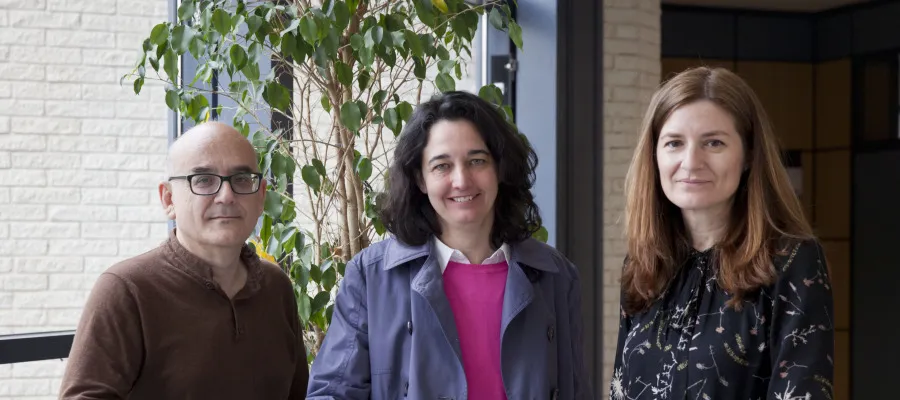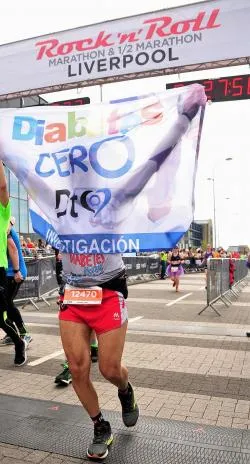Glucose detection in tears thanks to the mobile
Castellón researchers are developing an optical sensor with integrable nanoparticles in the chamber of smart mobile phones.
Jesús Lancis and Gladys Mínguez, both of the Groc, and Elena Sorlí, of the University General of Castellón.
Diabetes is a chronic pathology that demands good control of risk factors, an early diagnosis of the disease and adequate therapeutic management to minimize its impact.
In this scenario, the Optical Research Group (GOC) of the Jaime I University of Castellón (UJI), the Ophthalmology Service of the General University Hospital of Castellón and the company BQ are developing the Nanotears project, focused on the design of aOptical sensor with nanoparticles, integrable in the chamber of smart mobile phones, to detect the level of glucose in the tear of diabetic people.
According to Jesús Lancis, principal researcher of the Nanotears project and GROC director, photonic technologies and devices based on the use of light "play an increasingly significant role in resolving the challenges facing current society,"Among them the toilets.
non -invasive
With this perspective, the main objective is to develop a non -invasive, compact and integrated diagnostic device in the chamber of a smartphone, which will act as a pocket laboratory with which the concentration of glucose in tear in a simple way will be measured.
To do this, the key is to manufacture nanoparticles with laser technology based on the nanometric rupture of the desired material by using a pulsed laser.The level of glucose in a tear is directly related to its level in the blood and, therefore, tears constitute a target of interest for diabetes monitoring.
"Our technology allows access to the sample that is analyzed without the need to extract blood from the patient, thus eliminating the discomfort associated with the traditional puncture, such as pain and possible secondary infections. From the scientific point of view, the challenge is the detection ofThe glucose with the necessary precision in a medium in which it is about 50 times more diluted than in the blood.
Collection of tears
The Ophthalmology Service of the General of Castellón will be responsible for supervising the activity linked to obtaining samples of diabetes, both tear and blood, to develop the new measurement tool and correlate the values obtained from the glucose in tear in tearwith those of a conventional glucometer.
To initiate the sensor design, an adequate system for the patient's tear collection will be fundamental: this will be performed by a capillary of 20 microliters carefully positioned in the tear meniscThe characteristics of the sample, "explains Elena Sorlí, ophthalmologist of the General of Castellón.
Work will begin with a group of about 40 patients to make the necessary technical adjustments, and then the study with a broad group will be completed, still to be determined."In principle, the values obtained from the analysis of two groups will be compared, one of diabetic patients and another non -diabetic. In general, patients with ocular surface pathology will be excluded from the study," says Sorge.
laser
Next, the samples will be transferred to the Department of Physics of the UJI, where tears will be put in contact with the functionalized quantum points andThey will apply a blue laser light or LED to the sample.This will emit a fluorescence signal and, calibrating it, the amount of glucose will be calculated to develop the optical sensor that will subsequently be incorporated into the mobile phones camera.
From this device, glucose variations can be detected simple and quickly through simple fluorescent signal intensity changes.
The final product will be very compact and based on an optical sensor that allows its integration with the camera."Similar to how a lenses is placed, the patient will extract a tear from the eye that will contact the nanocomposed, producing a fluorescence signal that will be captured with the mobile phone camera. Finally, an application will directly allow you to know directly theBlood glucose level, "Lancis concludes.
The tear composition will be obtained by generating a fluorescence signal.
Scholarship.The initiative, which will begin in September of this year, is the first of the UJI that receives a help Marie Skodowska-Curie of the individual scholarship modality of the ‘Horizon 2020 'program.
Prototype.The forecast is to have a prototype of the optical sensor before finishing the project, in mid -2019, but its marketing will depend on its effectiveness, safety and commercial interest.
Diabetes.The prevalence of diabetes in Spain is 10.6 percent in men and 8.2 in women, according to WHO data, although some studies are raised up to 12 percent on average.
Source: Link





